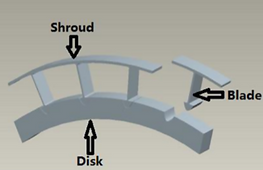Nonlinear Normal Modes of Piecewise Linear Cyclically Symmetric Systems
This work was done along with Assoc. Prof. Abhijit Sarkar.
Aim -
To use the concept of 'nonlinear normal modes' to understand the vibrations observed in the blades of a turbomachine that exhibit contact nonlinearity
Summary -
To reduce undesirable vibrations, turbine blades often incorporate a 'shroud' - a cap on the end of the blades separating them from each other. Under operating conditions, the blades deform and may interact with each other due to contact between the shrouds. This interaction gives rise to complex nonlinear phenomena. A classical linear approach to model the vibrations of these blades ignores this subtlety and therefore results in erroneous predictions and incorrect design guidelines. To get a realistic view of the system's dynamics, we incorporate the nonlinear contact interactions between the blades.

Fig 1a: Schematic of a shrouded turbine blade

Fig 1b: Schematic of a shrouded turbine blade's cross section shrouded
The concept of nonlinear normal modes (NNMs) is a useful tool to understand the free and forced vibrations of a nonlinear system. NNMs provide vital information on the system's forced response and the viability of a linear dynamics approximation. As part of this research project, we find the NNMs of a 3 degrees-of-freedom cyclically symmetric system, which is used as a toy model to gain an insight on the actual dynamics of the turbine blade system. By virtue of the three contact springs, this system is piecewise linear; it can be represented as a combination of several linear systems. To compute the NNMs, a shooting-based method incorporating a pseudo-arclength continuation was developed on MATLAB. A customised time-integration scheme based on a modified Runge-Kutta method equipped with event detection was also implemented. To the best of my knowledge, this project constitutes the first time the shooting-based method has been used to compute the NNMs for a system with multiple contact springs.

Fig 2: The 3 degrees-of-freedom toy model used to understand the turbine blade system
The computed NNMs are represented using a frequency-energy plot and were used to validate the predictions on the forced response. While one set of questions regarding the computation and usefulness of NNMs were successfully addressed, the investigation revealed that the system's NNMs exhibit rich nonlinear phenomena associated with bifurcations and stability. The forced response of the system also shows complex behaviour. To facilitate this analysis, bifurcation-detection and branch-switching capabilities have been incorporated into the code for computing NNMs and the forced response. Preliminary results on these topics have been obtained. These directions lay the path for current and further studies on the topic.


Fig 3a: Frequency-energy representation of the computed NNMs for two cases: zero clearance (dashed) and nonzero clearance (solid)
Fig 3b: The forced response of the zero-clearance system. The peaks are predicted exactly by the computed NNMs (green lines)
What I learnt -
-
Considerable expertise in MATLAB, numerical methods
-
Linear and nonlinear vibrations of discrete systems
-
An introduction into the world of nonlinear dynamics and various phenomena unique to nonlinear systems (studied Nonlinear Dynamics and Chaos by SH Strogatz)
-
An Introduction to perturbation methods (book of the same name by AH Nayfeh)
-
Numerical computation of bifurcation and stability diagrams on MATLAB (studied the book Practical Stability and Bifurcation Analysis by R Seydel)
Progress and Current Status -
-
Recreated key results from research work by Kerschen et al. on how to compute nonlinear normal modes for smooth systems
-
Numerical computation of nonlinear normal modes using a shooting method incorporating pseudo-arc length continuation
-
Corroborated results with Jiang et al.'s work on computing nonlinear normal modes for piecewise linear systems (i.e systems with contact nonlinearity)
-
Investigated and computed the nonlinear normal modes of systems of current interest: piecewise linear systems with cyclic symmetry
-
Drafting the manuscript and investigating additional phenomena (bifurcations, stability and forced response) on the sidelines
Rough Timeline -
-
March - June 2020: Learnt basic concepts, completed code for computing nonlinear normal modes for smooth systems
-
July - Oct 2020: Break
-
Oct - Nov 2020: Developed code and corroborated with existing results for piecewise linear systems
-
Nov - Dec 2020: Obtained plots and results for the systems of interest
-
Jan 2021 - Present : Documentation and exploratory plots
References -
-
Guofang Nan, Modeling and Dynamic Analysis of Shrouded Turbine Blades in Aero-Engines (American Society of Civil Engineers, 2015)
-
Kerschen et al. Nonlinear normal modes, Part I: A useful framework for the structural dynamicist (Mechanical Systems and Signal Processing, 2009)
-
Fig 1a: Guofang Nan, Modeling and Dynamic Analysis of Shrouded Turbine Blades in Aero-Engines (American Society of Civil Engineers, 2015)
-
Fig 1b: Development of a Shrouded Steam Turbine Flutter Test Case, Jinghe Ren (MSc Thesis, KTH, 2017)